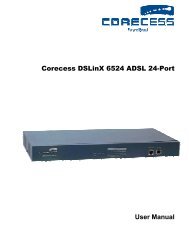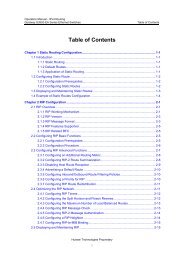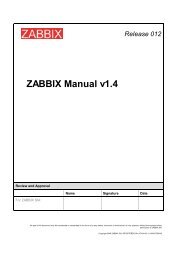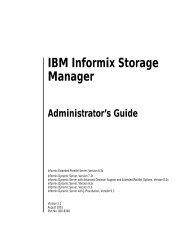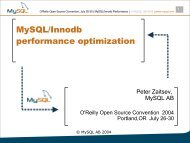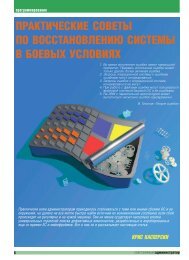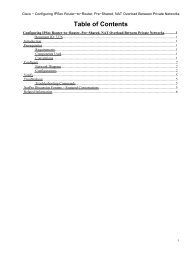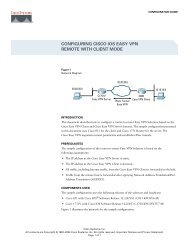Solaris Application Programming, 1/e - Chapter 4 - Parent Directory
Solaris Application Programming, 1/e - Chapter 4 - Parent Directory
Solaris Application Programming, 1/e - Chapter 4 - Parent Directory
Create successful ePaper yourself
Turn your PDF publications into a flip-book with our unique Google optimized e-Paper software.
4.3 TOOLS THAT REPORT CURRENT SYSTEM STATUS 57<br />
page: The columns labeled re to sr refer to paging information. The re column<br />
lists the number of pages containing data from files, either executables<br />
or data, that have been accessed again and therefore reclaimed from the list<br />
of free pages. The mf column lists the number of minor page faults, in which a<br />
page was mapped into the process that needed it. The pi column lists the<br />
number of kilobytes paged in from disk and the po column lists the number of<br />
kilobytes paged out to disk. The de column lists the anticipated short-term<br />
memory shortfall in kilobytes, which gives the page scanner a target number<br />
of pages to free up. The sr column lists the number of pages scanned per second.<br />
A high scan rate (sr) is also an indication of low memory, and that the<br />
machine is having to search through memory to find pages to send to disk.<br />
The solution is to either run fewer applications or put more memory into the<br />
machine. Continuously high values of pi and po indicate significant disk<br />
activity, due to either a high volume of I/O or to paging of data to and from<br />
disk when the system runs low on memory.<br />
disk: There is space to report on up to four disk drives, and these columns<br />
show the number of disk operations per second for each of the four drives.<br />
faults: There are three columns on faults (i.e., traps and interrupts). The in<br />
column lists the number of interrupts; these are used for tasks such as handling<br />
a packet of data from the network interface card. The sy column lists<br />
the number of system calls; these are calls into the kernel for the system to<br />
perform a task. The cs column lists the number of context switches, whereby<br />
one thread leaves the CPU and another is placed on the CPU.<br />
cpu: The final three columns are the percentage of user, system, and idle<br />
time. This is an aggregate over all the processors. Example 4.11 shows output<br />
from a two-CPU machine. With an idle time of 50%, this can mean that<br />
both CPUs are busy, but each only half the time, or that only one of the two<br />
CPUs is busy. In an ideal world, most of the time should be spent in user<br />
code, performing computations, rather than in the system, managing<br />
resources. Of course, this does not mean that the time in user code is being<br />
spent efficiently, just that the time isn’t spent in the kernel or being idle.<br />
High levels of system time mean something is wrong, or the application is<br />
making many system calls. Investigating the cause of high system time is<br />
always worthwhile.<br />
4.3.3 Reporting Swap File Usage (swap)<br />
Swap space is disk space reserved for anonymous data (data that is not otherwise<br />
held on a filesystem). You can use the swap command to add and delete swap space<br />
from a system. It can also list the locations of swap space using the -l flag, and



